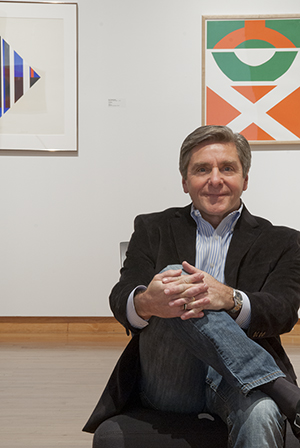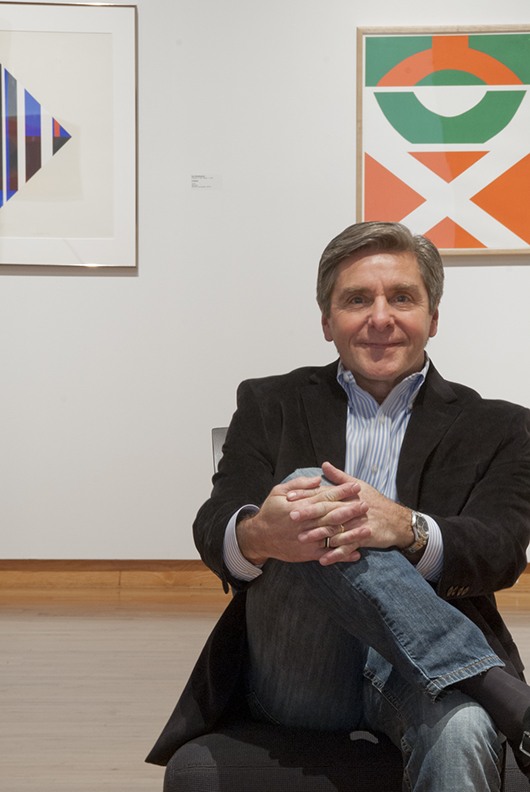
The wealthy Baltimore couple hang in two separate portraits in the Fort Wayne Museum of Art’s “Decade of Decisions: The Shaping of Collection” exhibit. The show focuses on items from more than 1,000 pieces Shepard says he has added to the museum’s permanent art collection in just 10 years as the executive director.
He automatically went to the portraits from the late 1800s when he began thinking of his favorite items. An antique dealer originally tried to sell the portraits to him for nearly $8,000 each. Outside of his intended budget with no attachment to Fort Wayne, Shepard declined. And kept declining for two years.
“Every time I would go in over the next two years, he lowers the price – I knew I had a good thing going,” Shepard told The Journal Gazette. “I keep telling him I’m not interested, he keeps lowering the price until finally, it’s a very cold spring – antique dealers are not selling anything in the wintertime anyway. It’s dismal, it’s rainy, there’s no customers out. I look at those portraits again, and he goes, ‘I will let you have those portraits for $800.’”
“I take it, because in two years’ time, I had researched the frames,” he says, pointing to the ornate golden borders around the portraits. “The frames together are worth almost $15,000. I figured I can’t go wrong.”
The current exhibit is full of these little anecdotes that Shepard loves to share. Over the past 10 years, he has more than doubled the museum’s art collection, while maintaining his aim for diversity in media and artists.
“It dawned on me that over all of those other years, many people had a hand in choosing, and sometimes, it wasn’t a choice. There’s never been a period in this museum’s history that one person could make that many decisions, which led to the title, ‘Decade of Decisions,’” Shepard said. “I also realized when you come in to see the show, the average person is not going to know anything about the work other than what’s on the label, so I’ve been upstairs for the past few days writing labels because there’s a little story behind everything and I think people would like to read the story.
“When a group calls for a tour, I’m usually the person that gives the tour because it’s fun to me. I tell you about the prices, how the deal happened and people love those tours. We’re working on how to incorporate more of that information. Museums don’t do that.”
The museum’s permanent collection consists of nearly 1,400 American paintings, sculptures, drawings, prints and photography; the collection also includes Indiana Amish quilts and hundreds of American cut glass work and highly collectible Roseville pottery pieces. Shepard says it’s culturally important to continue collecting pieces that stay within the city.
“You could have just a showcase – it wouldn’t be a museum then, it would be an art center – and you just change your shows; they’re all good and that’s all fun. But every time you do that, you have left no gas in the tank, so to speak. The only cultural treasure was there for a moment and you got to savor that treasure before it left,” he says. “By being a collecting institution, we are able to build a treasure trove that stays here and enriches the cultural landscape forever, really.
“Now the struggle of doing that is how much money do you have? Because museums that we all know have great collections, got those collections because they have really wealthy donors. We had to start from scratch, and buy, and barter and talk people into stuff, and it is difficult. But the fact that I’ve been able to add so much tells you it’s fun.”
Shepard came from New England, by way of Connecticut, in 2003 to elevate the museum, which included an expansion in 2010. Shepard says he took a year to compile a catalog of what the museum already had and what time periods, mediums and artists were missing.
This is where, at least for most artists, Shepard appears to differ from most. If a piece spurs his curiosity, he picks up the phone and calls the artist personally, if he can.
He says photographer Michael July, whose images from his book Afros: A Celebration of Natural Hair, were on display last year, was surprised that a museum director wanted to display his work in Indiana, when he couldn’t even manage to book a meeting appointment at a museum where he volunteered in Brooklyn.
Latino printmaker Paul Valadez was so happy that Shepard wanted to buy prints for the “Graphicanos” exhibit last fall, he willingly gave Shepard 24 more pieces of art.
X-ray photographer Nick Veasey, who Shepard says rarely sells his work for less than $10,000, had so much fun putting his work on display for the contemporary photography exhibit this spring that he told Shepard to keep all five pieces.
“He gave us almost $80,000 worth of his work,” Shepard says. “We are growing at unprecedented rate. We are really doing what I said we do – diversify, diversify, diversify. I think that really matters. Our community is diverse and anyone can be an artist. It’s not a closed gate like it used to be in the old day. It’s fascinating to see the reactions on the artists’ part, like Nick (Veasey), who tell me that this is not the way museums are doing it.”
“It shows me that we’re doing something different, and I always like doing something different.”
Shepard says he would like to add some more photography, studio glass and craft work pieces to the collection. He says he recently has found an interest in “artist-sculptor-bikemakers.”
“How crazy is that? There’s an artist that makes these crazy bikes that work, but they are sculptures,” he says. “I’m thinking I have to at least put one on display, and apparently he’s hard to deal with – I can’t wait to talk to him.”
___
Information from: The Journal Gazette, http://www.journalgazette.net
Copyright 2014 Associated Press. All rights reserved. This material may not be published, broadcast, rewritten, or redistributed.
AP-WF-08-15-14 1335GMT
ADDITIONAL IMAGE OF NOTE



